Nengi Omuku’s impressionistic landscapes and vibrant colour palettes create immersive spaces where her fluid, loosely rendered portraits of individuals and groups come to life. By blurring the boundaries between interior and exterior, figure and background, Omuku delves into themes of refuge and tranquility. Her work weaves together personal stories inspired by her recent experiences living in different countries, reflecting a deep exploration of space and identity.
A.S: The use of space is integral to your installations. How did you approach the curation and presentation process of your works in this exhibition?
N.O: The layout of the exhibition plan was established before the paintings were made. I knew I wanted to create a maze-like environment where viewers could enter the show and see both the front of the paintings and the back: the former front of the Sanyan textile, which is integrated into the artwork. I wanted the paintings to appear as objects in the space rather than merely being hung against the wall. It creates an immersive experience where you navigate the space, becoming aware of your body as well as what the paintings convey.
When I began working with Sanyan, I realized I was working with a heritage cloth, therefore engaging with a significant aspect of our culture in Nigeria, particularly for the Yoruba people. It was important for me, even though I was painting on this textile, to honor the fabric and present it to the world, highlighting that before colonization, we were engaged in a very intricate and refined form of craftsmanship—the art of weaving. I’m very aware that I am creating paintings on a pre-existing work of art, and that is what I wanted to showcase to the world, alongside the paintings themselves.
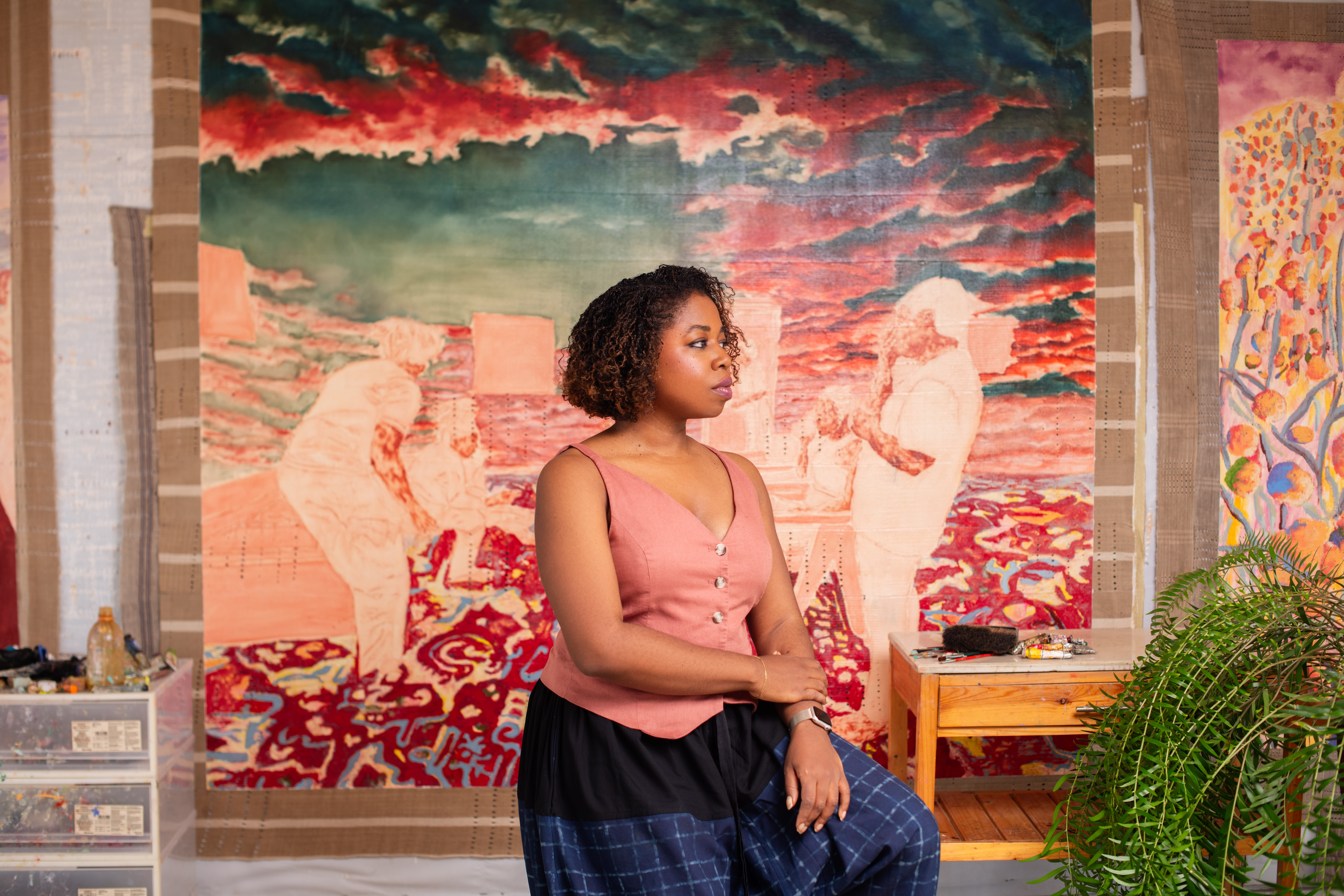
A.S: How did you get into using Sanyan? Did you try other fabrics or just landed on this by accident?
N.O: As a painter, my primary concern before creating the paintings has always been the surface. Ever since I was in art school, I’ve been obsessed with the surface on which the paint lands. The engagement between the brush and the surface is the foremost concern for every painter, even beyond composition, color, or anything else. It’s all about mark-making. In school, I experimented with various surfaces—wood, aluminum, paper—and displayed them in different ways.
However, when I came to Nigeria, I found it challenging to find good-quality canvas. I continued importing my canvas from England because I knew where to source high-quality materials there. I was also very interested in material culture. I was fascinated by the fact that you can identify an Igbo person, a Yoruba person, or a Hausa person based solely on what they are wearing, even before you speak to them.
This fascinated me, so after moving back to Nigeria, I started creating paintings of individuals seated in their traditional attire. At the same time, I was investigating the earliest forms of cloth. I wanted to learn about the first garments we wore before colonization and where this identification through material began. That’s when I started digging deeper.
When I arrived in Lagos, I knew that Aso-oke was the traditional fabric for the Yoruba people, but I asked friends about the earliest versions. That’s when a friend showed me his collection of Sanyan. When I saw it, it immediately reminded me of a surface I had used before; linen. It’s a surface I always gravitated toward in art school, but Sanyan seemed much sturdier, older, and rich in history and intricacy. I recognized it as a superior fabric to linen, which is why I started painting on it.
A.S: Do you have a favorite piece that you have created in this collection or in general?
N.O: The show is called, “Wild Things and Perennials.” because of the chaos surrounding the Nigerian elections, the fall of the Naira, and the NLC protests. But beyond politics, there were many chaotic events happening within my personal life as well.
In that period, my plants, flowers, and nature became a source of reprieve for me alongside painting. The show is really about finding balance in the chaotic world we live in. The chaos isn’t limited to Lagos; it exists everywhere. So, chaos is truly ubiquitous, and I aimed to address both the chaos in the world and the calm we must create for ourselves to maintain some degree of sanity and bring balance back into the world.
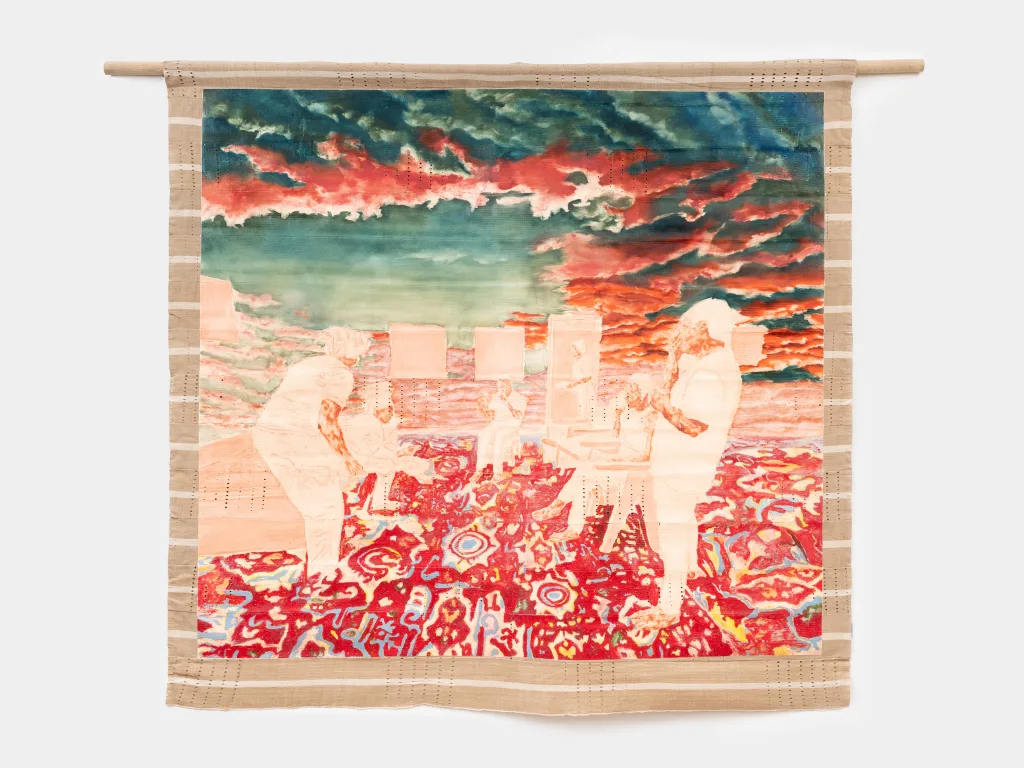

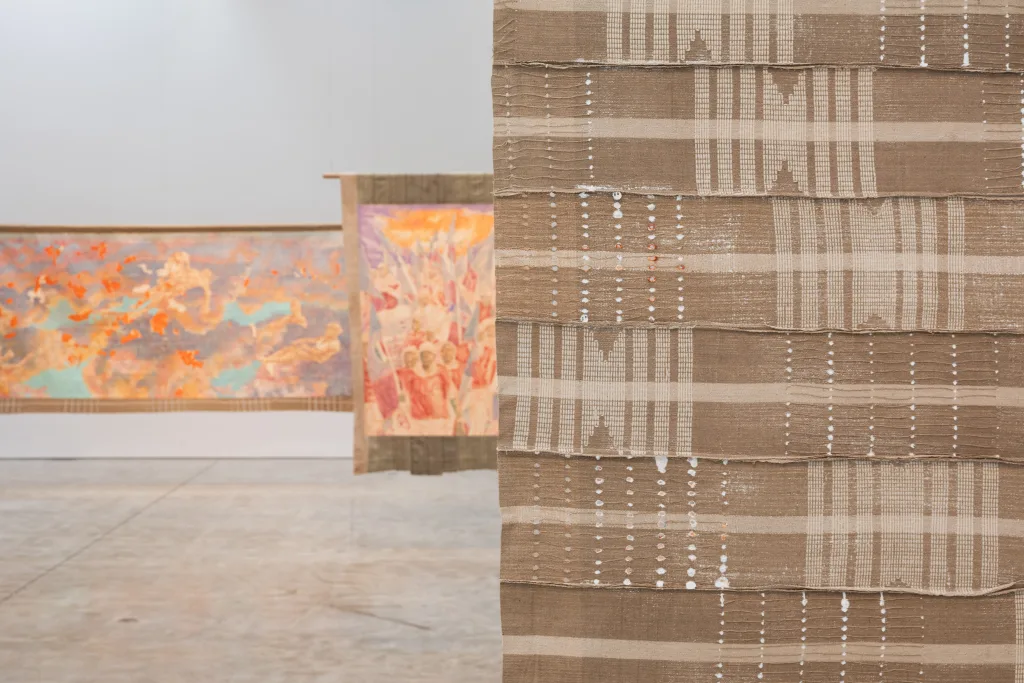
A.S: Do you have a favorite piece that you have created in this collection or in general?
N.O: No, I’m drawn to each of them. Each of them did something for me at very specific times. For example making, “I can’t feel my legs 2” was a meditative experience for me, made at the end of the year, transitioning into the beginning of the new year. It was just a quiet, still, extremely laborious way of meditating by making tiny brush marks over a very large surface. It was the painting that took the longest time, but still, the painting is about rest.
“Orange Bougainvillea” was made after the fire in my studio building. It was made intuitively and emerged for a specific reason: to calm my mind after a chaotic event. “NLC” was created after I witnessed the NLC protests. I have made many protest pieces in the past, and when the NLC came out in that very distinct way with all of their uniforms and flags, they were basically saying, “enough is enough.” I knew that it had to be a painting. It was a collage of different images that I found to create that piece, and it was made on vintage Sanyan that had green and beige stripes, almost like the Nigerian flag.
I was thinking about Nigeria historically and how we have this rich history of something so beautiful, intricate, and perfect—like weaving—while we are the ones creating chaos through our politics and all of the strangeness happening in the government. I knew that that painting had to go on one of the most prized vintage Sanyan piece that I had. Each of them did something different for me at a very different stages.
A.S: What has been the most rewarding experience in your career so far?
N.O: I have had a couple of institutional shows that have been amazing, but being selected for a solo booth at Frieze by an artist I’ve admired for the longest time, Sir Yinka Shonibare, has been a major highlight of my career. I’ve loved his approach to making and research within his practice since I was in art school. So, just being seen by him at this time has been the most humbling experience for me.
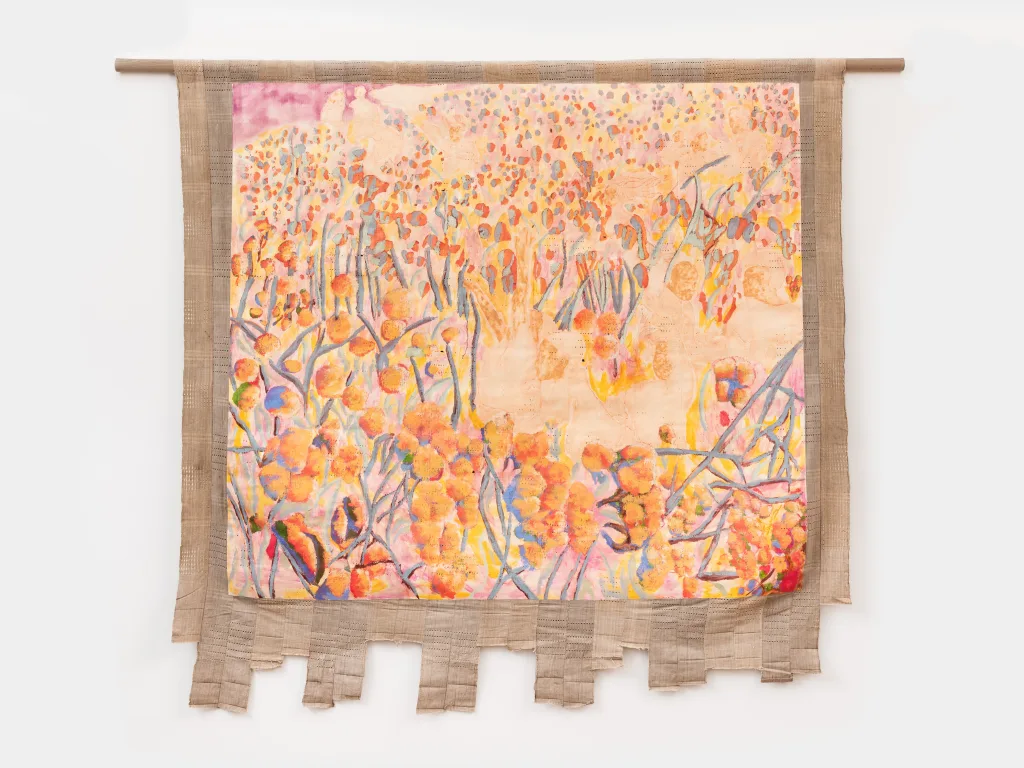
© Nengi Omuku. Courtesy of the artist and Kasmin, New York.
A.S: Who are the people and elements that influence your work the most as an artist?
I greatly admire the work of Wangechi Mutu. She helped me realize that there are many ways to think about the body within art and that we can free ourselves from the limitations of representation. We can dream beyond what we see in reality. I believe that this realization unlocked the body for me and inspired my approach to painting, particularly in how I depict people and bodies in my work.
The landscape paintings are largely inspired by my mother. She is a landscape designer, gardener, and florist. I worked with her for five years after art school, and I think that experience had a significant influence on my practice in terms of composition, color, and new subjects, as I paint a lot of landscapes now.
A.S: It’s really good. So what do you hope the audience will take away from this work?
N.O: I hope that when people walk into the exhibition, they can feel a sense of calm and rest through the paintings in spite of the fact that many of the paintings are drawn from chaotic moments. I want to create a sense of solidarity in our shared struggles globally and create a quiet space for calm reflection.
These themes run throughout the show because I want to highlight the importance of moments of rest. Another exhibition“The Dance of People and the Natural World.” is a more targeted and focused show that just ended at a museum in Bristol, the Arnolfini. It centered on the theme of people resting in nature. Emphasizing a sense of oneness with the environment, where there is no hierarchy and humans are not elevated above the landscape. There is equality, and nobody is harming anyone; everyone is just quietly passing through.

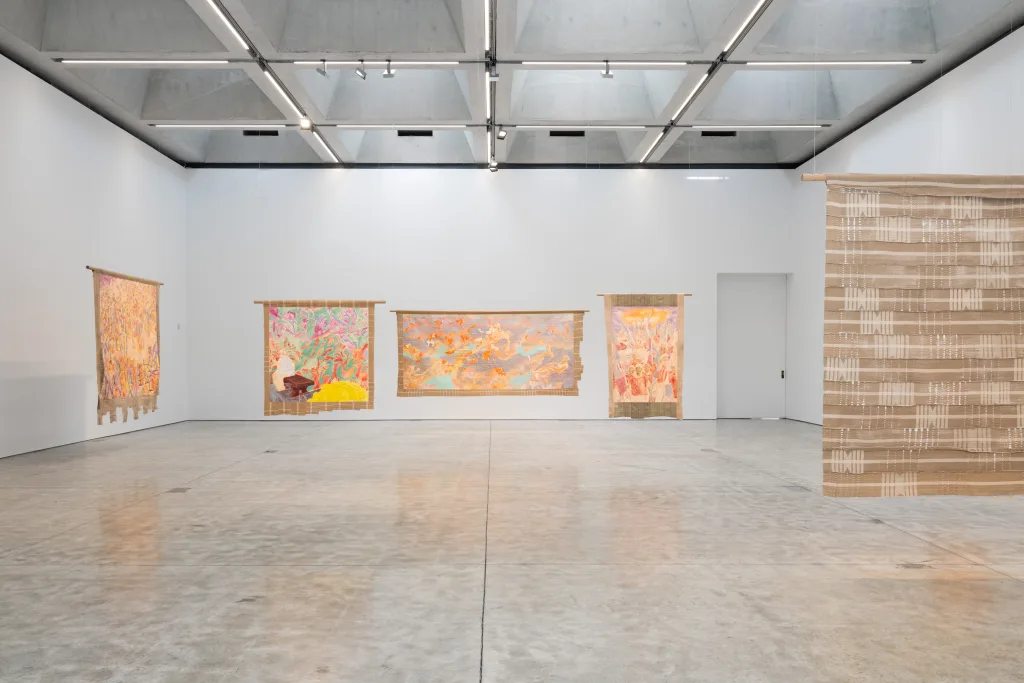
A.S: How has your artistic style developed over the years and what has been? What would you say is the biggest turning point for you over the years since you started?
N.O: Working on Sanyan was a major determining factor for the shift in my palette. I was working with a vintage textile, and I realized that I needed to move away from the hot, very primary colors I had been using. My palette became more muted in response to the textile because I didn’t want it to feel like an alien invasion of this vintage, pre-colonial, textile. I wanted it to appear as if it was one with the surface.
The way I approached the body has also transformed over time. I started with figuration during my bachelor’s degree, then moved into pure abstraction during my master’s. After my master’s, I moved to Nigeria. For six years, 2012 to about 2018, I spent time figuring out what I wanted the bodies in my work to represent. It began with a very fragmented body made up of different components to convey the idea of being multifaceted as individuals. Eventually, I realized I wanted to focus on a state of mind rather than representation.
A.S: What advice would you give to young or emerging artists who are just starting their careers?
We are all, myself included, continuously evolving. You may wake up asking, “Who am I as an artist?” You will question yourself, and I question myself constantly. It is crucial to embrace that questioning, to be grateful that these questions arise, and to keep pushing through, experimenting, and digging deeper into your practice.
The only way to emerge on the other side of those initial questions is through making. Even when you find yourself in a newfound landing area, more questions will arise, and you will continue experimenting until you find another landing area. It’s like gradually ascending a staircase that never ends. That’s the joy of it. If we don’t, we risk becoming stagnant.
For more updates from Nengi, you can follow her on Instagram @nengiomuku and Kasmin Gallery for more.


